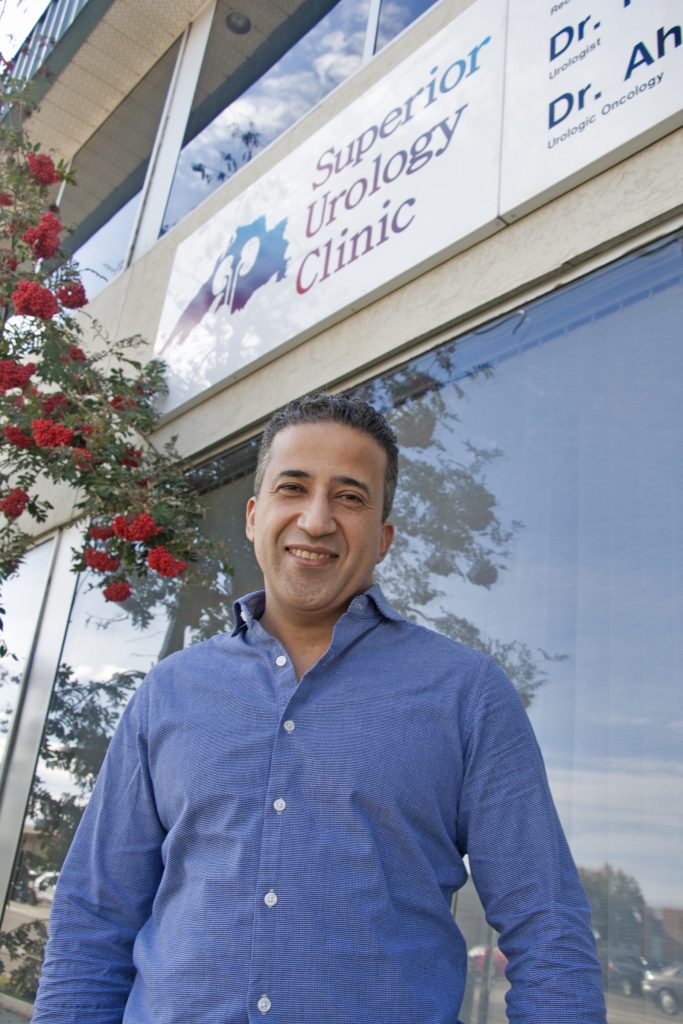New Kidney Stone Equipment Makes Surgery Faster and Safer
by Graham Strong
 The addition of a new Lumenis MOSES laser and a Shockpulse-SE – along with experienced urologists here including Dr. Elmansy (pictured) – are helping make Thunder Bay a well-recognized centre for urology in Canada, and enhancing patient care through innovative research and surgical techniques. Thanks to donors who have supported the purchase of new equipment, world-class urological care is possible.
The addition of a new Lumenis MOSES laser and a Shockpulse-SE – along with experienced urologists here including Dr. Elmansy (pictured) – are helping make Thunder Bay a well-recognized centre for urology in Canada, and enhancing patient care through innovative research and surgical techniques. Thanks to donors who have supported the purchase of new equipment, world-class urological care is possible.Kidney stone surgery has always had a high risk of side effects including bleeding and the need for follow-up surgery. That’s because using traditional surgical methods of removing kidney stones is tricky. Urologists literally smash the kidney stone with a laser or a small jackhammer-like device, which often sends pieces flying. To get a basic idea of the difficulty, imagine splitting rocks with a sledgehammer while trying to control where the fragments go.
However, Thunder Bay’s urology program purchased two new devices to better control those fragments. The equipment will help reduce surgical risks and make kidney stone surgery faster, safer, and less invasive than ever before.
One new device is the Lumenis MOSES laser system, the most advanced system for kidney stone removal. This dual-laser system gives the urologist much more control during the kidney stone operation.
“It’s all physics. With our current machine, the laser creates a vapour bubble. When the bubble collapses, it creates turbulence, pushing the stone away,” said Dr. Hazem Elmansy, recognized as an expert in the management of kidney stones.
That increases the chance of fragments getting lost or lodging in different locations in the kidney. Urologists spend a lot of time during the operation tracking down those fragments.
“With the MOSES technology, the stone doesn’t move when we hit it with the laser. That means shorter operations, a lower risk of bleeding, and a much lower chance that we would have to operate a second time.”
The MOSES laser accomplishes this by using two laser beams. One “parts the way” before the second follows immediately behind to hit the stone. (The name “MOSES” comes from the biblical Moses parting the Red Sea.) There is much less turbulence during the strike so the stone tends to stay in place while the laser breaks it down. Another device simultaneously suctions the pieces as they fragment for faster, safer removal.
This versatile laser will also be used for treating benign prostatic hyperplasia or BPH.
The other piece of equipment for kidney stone surgery is the Shockpulse-SE. This is used for kidney stones that are too large for the laser technique. The machine uses a combination of ultrasonic waves and a jackhammer-like action to break down the stones. Like the MOSES laser, it too suctions fragments throughout the procedure, speeding up the process and reducing the risk of fragments moving and hiding from view.
Total operating time depends on the size of the stone, but the time difference is enormous.
“If our current machine can finish the stone in two hours, this strong machine can finish it in maybe thirty minutes. That means patients are under anesthesia for a shorter amount of time,” Dr. Elmansy said.
The addition of these two new pieces of equipment – along with experienced urologists here including Dr. Elmansy – are helping make Thunder Bay a well-recognized centre for urology in Canada.
“Our goal is to enhance patient care through innovative research and surgical techniques,” Dr. Elmansy said. “Our patients deserve access to the highest quality care.”
Programs like our world-class urology program this can’t exist without the support of our generous donors. Please, help us ensure we have the best possible care right here in Thunder Bay. You can contribute to improving our urology program or any other program at our Hospital by donating to the Thunder Bay Regional Health Sciences Foundation online at: healthsciencesfoundation.ca/urology.